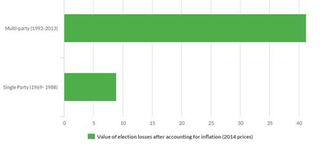Kenya loses billions due to election turbulence

SOURCE: WORLD BANK
What you need to know:
- The losses are conservative since they do not consider how much more the economy would have grown if it did not have to keep recovering from slowdowns caused by political unrest.
- The difference between GDP growth rate in election years and non-election years during the multi- party era is double that of the difference in GDP growth rate between election and non-election years during the single party period.
- The analysis finds that it took longer for Kenya to recover in the multi-party era than before pluralism of political parties.
Kenya has lost about Sh50.07 billion as a result of economic slowdowns during election years since independence, an analysis of economic and election data since independence reveals.
This amount is almost seven times the government expenditure on housing development and human settlement in the 2015/2016 fiscal year.
It is also more than 10 times what has been allocated to industrial developments and investments in the current financial year, according to the analysis by Nation Newsplex and Institute of Economic Affairs.
The losses, which were calculated using the value of the shilling in 2014 and adjusted for inflation, found that in both single and multi-party periods after independence, the GDP growth rates for all non - election years are higher than the average pace of GDP growth for all the years, including election years.
It took longer for Kenya to recover in the multi-party era than before pluralism of political parties.
Over the single party period, 1963-1990, the difference between the average GDP growth rates inclusive of the five election years and GDP growth rate excluding the election years, is 0.12 per cent, which translated to a loss of Sh8.9 billion according to 2014 prices.
This amount is 12 per cent more than what the national government allocation to maternal and child health in the financial year 2015/16.
During the multiparty period 1992-2014, the difference between the average GDP growth rates inclusive of the five election years and GDP growth rate excluding the election years is 0.24 per cent, which is equivalent to Sh41.17 billion.
However, the losses are conservative since they do not consider how much more the economy would have grown if it did not have to keep recovering from slowdowns caused by political unrest.
That amount equals the entire government expenditure on primary education and quality assurance and standard for education for the 2015/16 fiscal year. The amount is also 28 times more than what was allocated to research, science, technology and innovation in the current financial year.
The larger difference in the average GDP growth rate between election and non-election years from 1991-2014 of 0.24 per cent confirms that election campaigns had a negative impact on the economic growth rate which was greater in the multiparty system than the single party one.
TIME TO RECOVER
The difference between GDP growth rate in election years and non-election years during the multi- party era is double that of the difference in GDP growth rate between election and non-election years during the single party period.
This leads to a conclusion that election politics have been more polarised, and the outcome of elections more uncertain in the post-single party period, resulting in significantly reduced economic progress for Kenya, especially since 1992.
The review also looked at the average number of years it takes for Kenya to rise from the lowest to the highest point in terms of GDP growth rate (i.e. period between troughs and peaks).
It took longer for Kenya to recover in the multi-party era than before pluralism of political parties. In the period 1963-1990, it took 18 months on average for Kenyan economy to move from the lowest point (trough) to the highest point in terms of GDP growth rate.
However, in the period, 1991-2014, it on average took 26 months for the economy to move from the lowest point to the highest point in terms of GDP growth rate. This means that economic recovery took eight months longer in the era of political pluralism.




